Mikem Member Username: Mikem Post Number: 1295 Registered: 10-2003 Posted From: 68.43.13.241 |
The Windsor Kelsey-Hayes was the first plant to get a Canadian UAW local. Did Kelsey-Hayes have a red neon "bulldog" sign on top of the plant, visible from I-94? I seem to remember something like that, thinking it was a Mack Truck plant. Sven has asked for more aerial shots. Here is the former Plymouth Lynch Road Assembly Plant, Huber Foundry, and Eldon Ave plants, looking northeast. 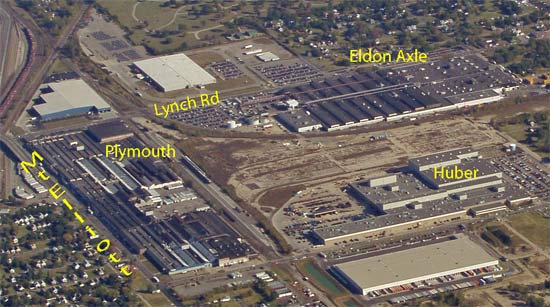 Lynch Rd Assembly is at the SE corner of Lynch & Mt Elliott. To the east on Huber St is Chrysler's Huber Foundry, now owned by the Detroit Water & Sewage Dept:
North of Huber, at the corner of Lynch Rd and Eldon Ave is Chrysler's Eldon Avenue Gear & Axle Plant, once its sole supplier of axles. Eldon Ave was the scene of an early workplace shooting spree when James Johnson killed three co-workers including his foreman. Eldon Ave, being a foundry, was a noisy, dirty, and dangerous place to work. In the late sixties, Eldon was one of many plants where a Revolutionary Union Movement (RUM) formed (ELRUM - ELdon Ave RUM), when black workers found that the UAW was neglecting their concerns in the workplace. This excerpt on "niggermation" and the RUM movement from "Detroit I Do Mind Dying" by Dan Georgakas and Marvin Surkin:
Continued at http://www.geocities.com/cordobakaf/glaberman_black_cats.html | ||||||||||||||||||||||||
Jjaba Member Username: Jjaba Post Number: 1492 Registered: 11-2003 Posted From: 24.22.6.155 |
As always, MikeM gives us photos and map and aerials and text, well sourced. WOW! jjaba did more research on Desotos, Wyoming and Mc Graw so here it tis. MikeM was on to something. What today is known as the Chrysler plant at Wyoming and Mc Graw has a varied history, by product, use, and ownership. Hugh Chalmers built a car there called the Saxon. His company was started in 1913 and in 1913 under the leadership of Harry Ford, they built a plant here. Harry tried to compete with Henry Ford's Model T. In Feb. 1917, the plant burned to the ground. That same year, a new plant was built to construct Liberty Engines for airplanes. It was wartime in Detroit. The plant was Liberty Motors then. By 1922, Saxon was kaput. General Motors bought the Liberty Plant and in 1926 and 1927 built their fine La Salle cars there. Enter Chrysler who in 1936-1942 made the delightful Desoto here at Wyoming and Mc Graw. After the WWII, Desotos ran on the line again 1946 and 1947 after which Desotos went over to Jefferson Avenue Assembly. This event was a homecoming of sorts since Desoto began over there in 1928. On the complex are three distinct building styles; the 1917 small brick two-story bldg., a substantial three-story concrete reinforced factory 300 ft. long by 60 ft. wide, and the Albert Kahn Bldg. discussed by jjaba earlier. The Desoto Press Shop of 1936 gained intl. recognition for industrial design. The addition in 1942 gained recognition for simplcity of design. Somewhere in all of this are references to a Glass shop within the ensemble. So you have it; on one Detroit Westside industrial piece of land, Saxon, Liberty, GM LaSalle, Desoto, & Chrysler. Since jjaba grew up near there, he knows it as Desotos. He remembers the men on the Wyoming bus with empty lunch boxes coming up from The Rouge and Desotos at shift change, full of the stink of shaved metal. As in all of us, what we know is what we know. Everything else, we have to dig for. The history is fascinating. jjaba | ||||||||||||||||||||||||
Mikem Member Username: Mikem Post Number: 1296 Registered: 10-2003 Posted From: 68.43.13.241 |
Yes, LaSalle, that's it! Here's a comparison between 1949 and 2002. Looks like the western part has been demolished for parking and a newer addition. Wondering if the original laSlle factory was the portion that was torn down? 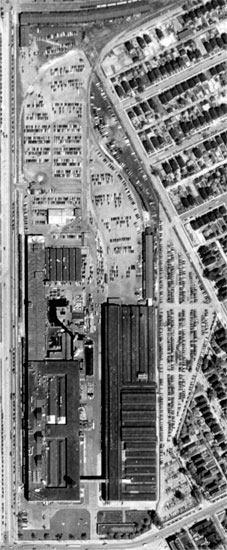 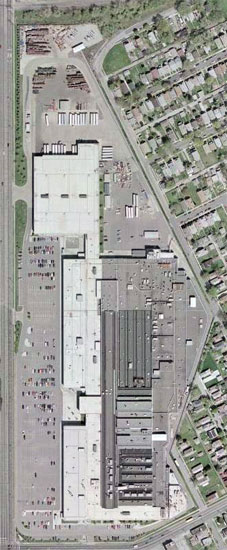 The street on the west side is Wyoming, and McGraw on the south. As a side note, in the original '49 photo you can see where the "Detroit Industrial Expressway" started/ended at Michigan Avenue just southwest of the plant. Construction has started on extending the future Edsel Ford Freeway into Detroit by cutting a swath eastward through the neighborhood on the north side of Michigan Ave: 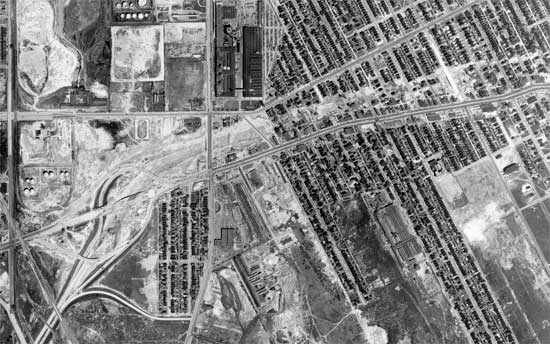 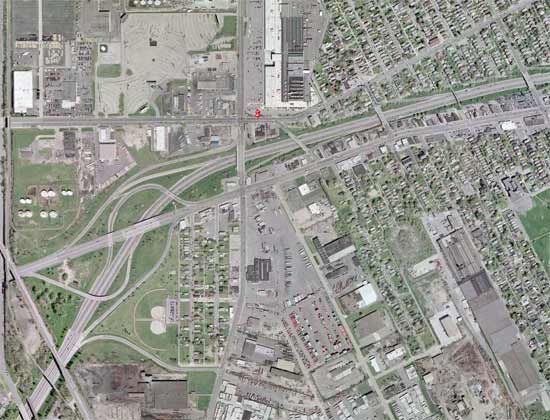 | ||||||||||||||||||||||||
Mikem Member Username: Mikem Post Number: 1297 Registered: 10-2003 Posted From: 68.43.13.241 |
Can we pin down the age of a factory by its features? I love the vents with the fins to make them pivot downwind. I wonder how effective they were? What venting technology replaced them? What did they relpace? Were there exhaust fans in the base, or was it simply hot air rising? What was the nature of the business underneath? Are they good enough for foundry work or only for less heat intensive operations? 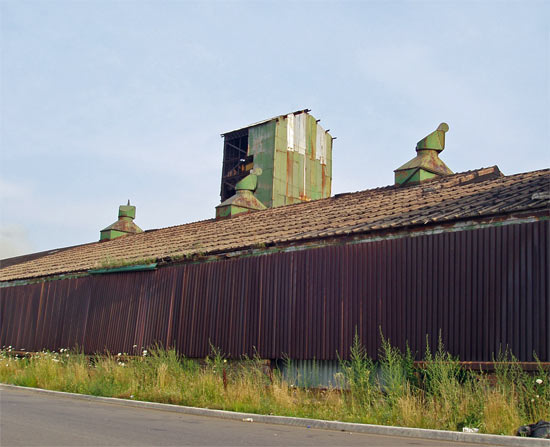 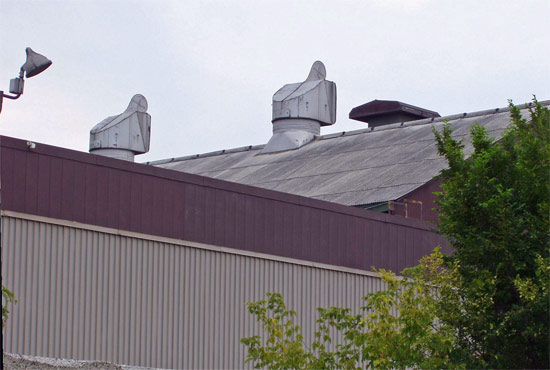 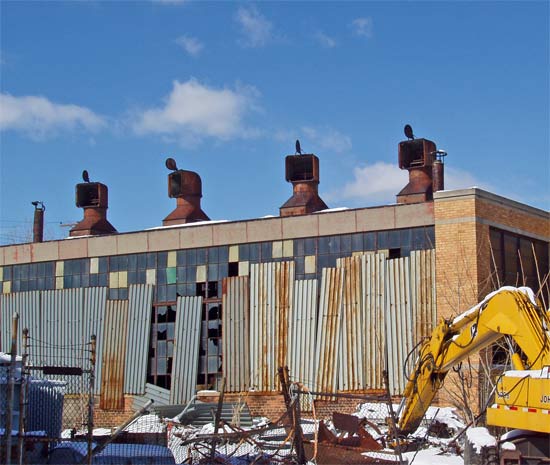 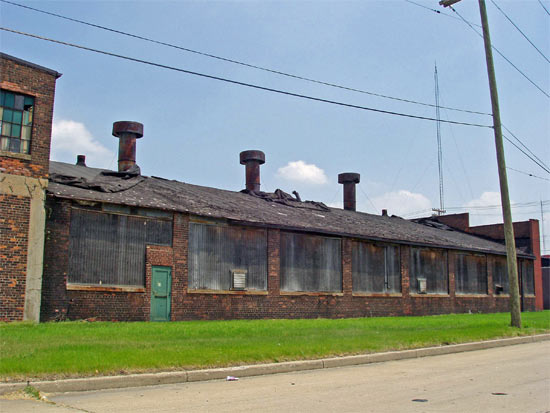 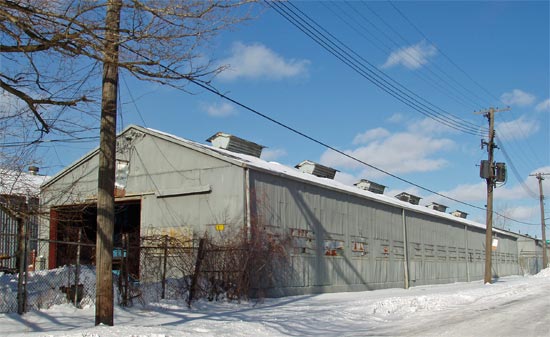 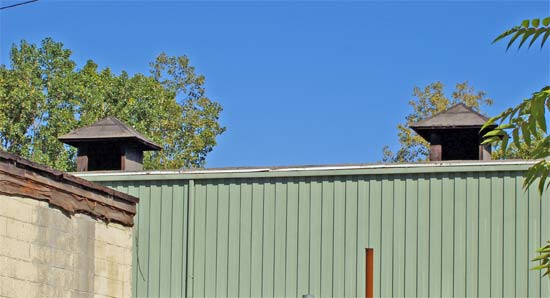 | ||||||||||||||||||||||||
Rustic Member Username: Rustic Post Number: 1345 Registered: 10-2003 Posted From: 130.132.177.245 |
MikeM thanks for the link to the working conditions at Lynch Rd in the early 70's. These old industrial buildings, evocative and powerful and ghostly beautiful as they are, are merely shells. The products they produced, tho important and awesome were merely things ... it is the thousands and thousands of people working in these buildings (and others) and what they went through and their experiences that are the real story. Yay Detroit! and keep it coming this great thread is only getting better ... | ||||||||||||||||||||||||
Bate Member Username: Bate Post Number: 28 Registered: 02-2005 Posted From: 4.247.134.226 |
Hope Mikem keeps one hand on the controls while taking those areials. Are you private or commercial? I hope this thread is alive and well when I return. I'm being forced into a 10 day vacation away from technology. Cheers | ||||||||||||||||||||||||
Sven1977 Member Username: Sven1977 Post Number: 27 Registered: 04-2004 Posted From: 209.220.229.254 |
You guys are awsome! Great info. The aerials really show how close everything is. Not being a true "car guy," is the Lynch Road plant now closed? From the overhead shots of the McGraw area, you can see the old Rickenbacker factory to the bottom right. | ||||||||||||||||||||||||
Jjaba Member Username: Jjaba Post Number: 1494 Registered: 11-2003 Posted From: 24.22.6.155 |
The Mc Graw-Wyoming complex made glass. This would have taken a building with good venting. The 1936 Albert Kahn Bldg. with the 1941 separate addition are described as both Press Shop and Glass Plant. The incarnations and reincarnations are amazing in these factories. One location, Saxon cars, Liberty Airplane Engines, LaSalle cars, Desotos, and many components like glass for a whole line of Chrysler products. Here's the administration of Desotos. During the life of Destoto cars, Chrysler Corp. had three major chains; Chrysler, Dodge, and Desoto. Each of them also sold Plymouth. Later, they added Imperial as another chain, who also sold Plymouths. In price, Desoto was in the middle. With such post-war competition just within the Chrysler family of vehicles alone, Desoto got squeezed from both sides. By 1961, they were kaput. Yes, the Detroit Industrial Expressway of 1942 (aka Willow Run Expy.) ran from Wyoming Avenue Detroit City Limits out to Willow Run Bomber Factory. Later, The Edsel Ford Expy. was plunked down in an existing neighborhood East all across Detroit on the way to Port Huron, Michigan as I-94. From Wyoming to Vernier Rd. in Harper Woods, a huge swath of Detroit, was done in 1959. jjaba, Westsider. | ||||||||||||||||||||||||
Sven1977 Member Username: Sven1977 Post Number: 28 Registered: 04-2004 Posted From: 209.220.229.254 |
Mike, Your middle picture with the green door, it's at Morrow and Marston. Do you know what that building was originally? | ||||||||||||||||||||||||
Eastside Member Username: Eastside Post Number: 170 Registered: 01-2005 Posted From: 69.242.221.202 |
That light has..."got me straight tripping." | ||||||||||||||||||||||||
Mikem Member Username: Mikem Post Number: 1298 Registered: 10-2003 Posted From: 68.43.13.241 |
Bate, I plead the fifth. Enjoy your break from technology, something everyone should be forced to do once a year -- roughing it! Sven, Plymouth Lynch no longer assembles cars but it is in use. I think the city might even own it. Eldon is still owned and used by Chrysler. The set of shops on Marrow looks older than 1930, which is what the city's website gives as a date built. I don't know if it was originally part of the Chevrolet Gear and Axle complex to the north (GM's only plant in Detroit that wasn't Cadillac?), now American Axle, or a smaller shop. 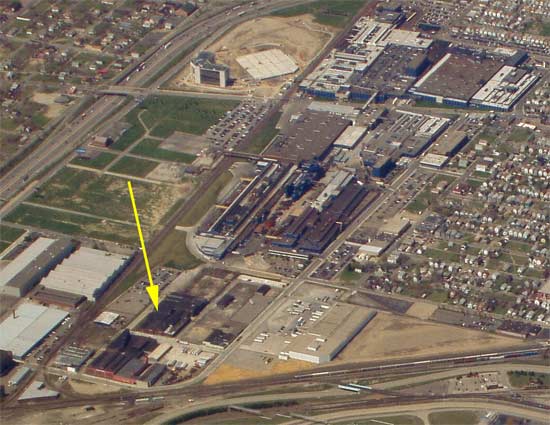 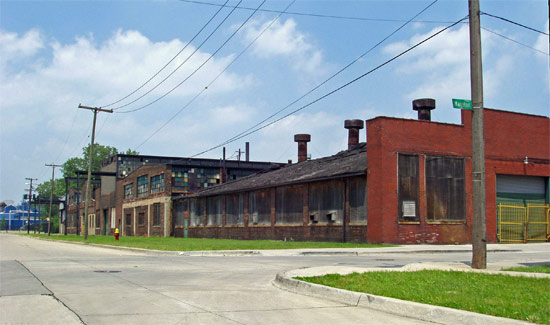 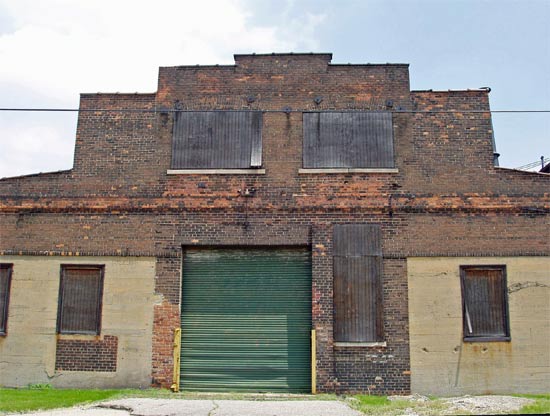 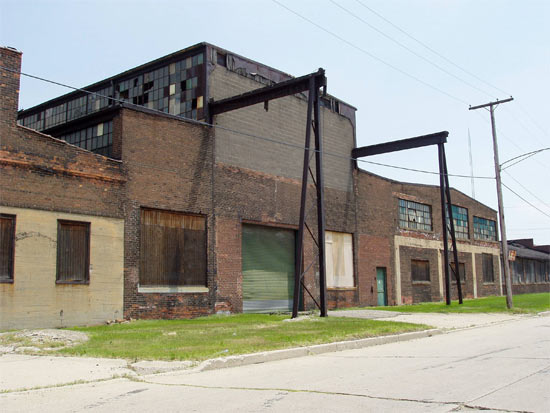 The cross street to the north, between these buildings and American Axle, is Euclid to the west through midtown, Denton to the east through Hamtramck, but for a few blocks here, it used to be named Vulcan, probably because of the Chevy foundry but maybe these were part of a foundry/forge operation? Rustic, think of the thousands in this area alone, who could tell us stories of working in these places. No matter how boring or monotonous it could be, there are always some "characters" that keep it interesting and fun. Here's more for you, about Chevrolet Gear & Axle, from "The Bread of Time" by Phillip Levine, a former Detroiter turned poet:
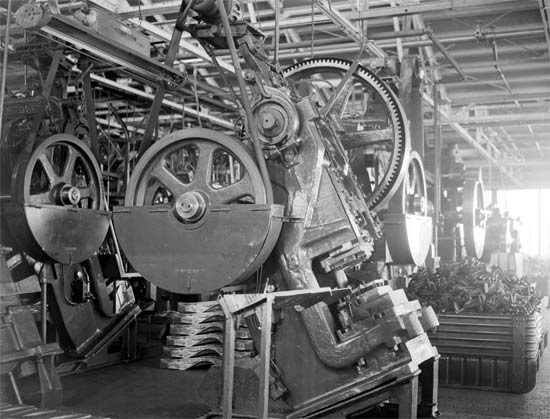 Maybe jjaba can find the origins of this plant? A source I have says it was built for WWI production before Chevy took over. | ||||||||||||||||||||||||
Aiw Member Username: Aiw Post Number: 3490 Registered: 10-2003 Posted From: 209.216.150.127 |
Mike the mid teens look more realistic as a date of construction than 1930, architecturally speaking... Also when did GM Buy out Fisher Body? I was doing some research today in Windsor, and a fire insurance map from 1937 showed the Windsor Fisher Body Plant clearly labeled as "General Motors of Canada". | ||||||||||||||||||||||||
Mikem Member Username: Mikem Post Number: 1299 Registered: 10-2003 Posted From: 68.43.13.241 |
AIW, essentially 1919. Here's a summation on Fisher from Jame's Rubenstein's "The Changing US Auto Industry":
While were talking bodies, I have these other histories from 1922: J. W. Murray Manufacturing Company (Murray Auto Body), located at Clay and St Aubin, incorporated in 1913 for the purpose of manufacturing auto hoods, fenders, tanks, pans, and other sheet metal parts for automobiles. In 1920, the company purchased the plant of the General Spring & Wire Company and the American Motor Castings Company. In 1919, a Cleveland plant was also opened. The forerunner of the Russell Industrial Center: 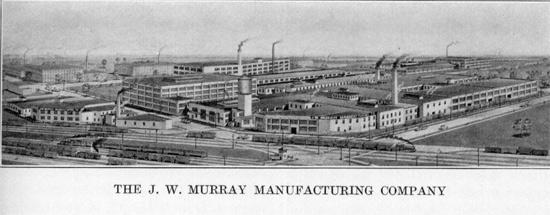 Trippensee Manufacturing Company, engaged in the making of automobile bodies, with a plant located at Stanley Avenue and Twelfth Street, was started in 1906 as manufacturers of Trippensee Planetarium (?) and wood specialties. The building of automobile bodies was begun in 1907. C. R. Wilson Body Company, incorporated 1899. This business was the outgrowth of that started in 1870, when C. R. Wilson came to Detroit and in 1875 began the manufacture of buggy woodwork. In 1876 he was joined by his brother, J. C., and the company was incorporated in 1886 as the C. R. & J. C. Wilson Carriage Woodwork Company. The brother afterward sold his interests in the company and the name became the C. R. Wilson Body Company. C. R. Wilson became interested early in the automobile development, in the manufacture of bodies for the machines, and in this way became connected with the founders of the Ford, Olds, and Cadillac plants. His first work was done for these makers. This company now, which in normal times employs about 2,500 men, has its principal plant located on Clay Avenue and the Grand Trunk Railroad. Finally, I have the Motor Products Corporation, located at Mack and Hart Avenues, incorporated 1916, and took over the business of the Rands Manufacturing Company of Detroit, the Diamond Manufacturing Company of Detroit and Walkersville, the Superior Manufacturing Company of Ann Arbor, the Vanguard Manufacturing Company of Detroit, and the Universal Metal Company of Detroit. These companies were engaged in the making of miscellaneous products from steel, brass and copper, and automobile accessories. In 1916 the company acquired their present plant, which were the buildings of the old Lozier plant. {So the Lozier plant became Motor Products which became Chrysler and was located where the new Chrysler Mack Engine plant is now.} | ||||||||||||||||||||||||
Mikem Member Username: Mikem Post Number: 1300 Registered: 10-2003 Posted From: 68.43.13.241 |
Hmmmm....Trippensee Planetarium, made in Detroit on 12th Street: 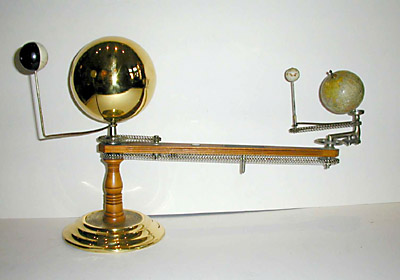 But I digress... | ||||||||||||||||||||||||
Jjaba Member Username: Jjaba Post Number: 1503 Registered: 11-2003 Posted From: 24.22.6.155 |
jjaba is bowled over by MikeM's incredible site. We've never seen anything like this. It is wonderful. Merci! Gracias! Danke! Mazel tov! jjaba will continue to research the questions but just can't type fast enough AND have a life too. jjaba | ||||||||||||||||||||||||
The_rock Member Username: The_rock Post Number: 569 Registered: 11-2003 Posted From: 68.42.250.243 |
Mikem--next time you are landing that Airbus at Metro, vector off to Pontiac ( the passengers will hardly notice) and snap a few pictures of the former auto plants in Pontiac. LOTS of history there between the Oakland and the Pontiac automobiles. I can still picture row after row of military vehicles all lined up at the GM plant(Northwest corner of Saginaw and South Blvd.) awaiting shipment overseas during WWII | ||||||||||||||||||||||||
Aiw Member Username: Aiw Post Number: 3496 Registered: 10-2003 Posted From: 65.92.103.76 |
So today's lesson is about Fire Insurance Maps. I don't know if there were a Canadain only thing, or if they existed in the US as well. These are the best thing a resercher can come across, as they were produced for the insurance industry, there are many details on the maps. They are kind of like labeled areial surveys.... Here is the old Fisher Body in Windsor: 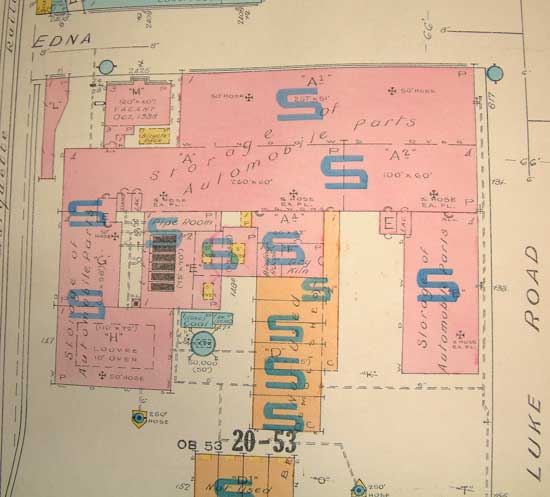 I also found out there was a Gar Wood Plant here as well.. The plant is long gone, a banquet hall sits on the site, however around the corner, my city map shows "Garwood Park" 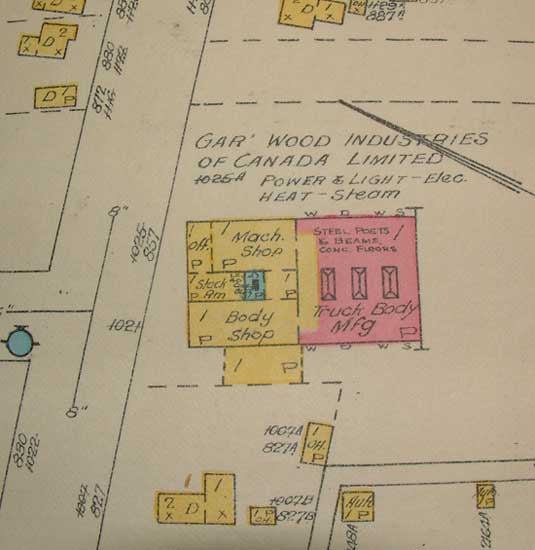 I pinned down the location for the Windsor Graham-Paige 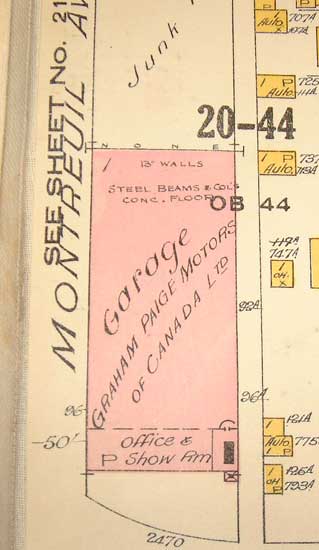 Drove by today, and surprise, it's still there... 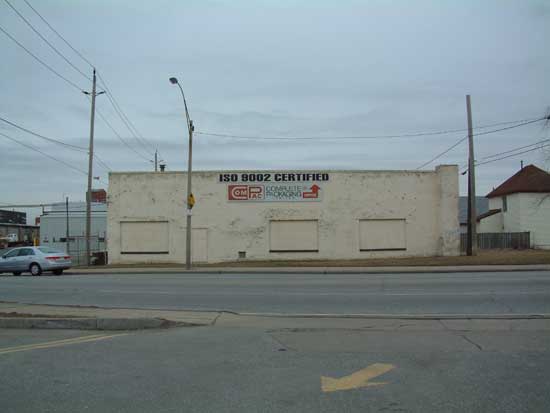 Got the layout of the Studebaker Plant: 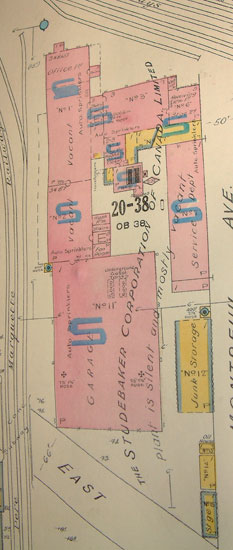 It looks like portions are still there: 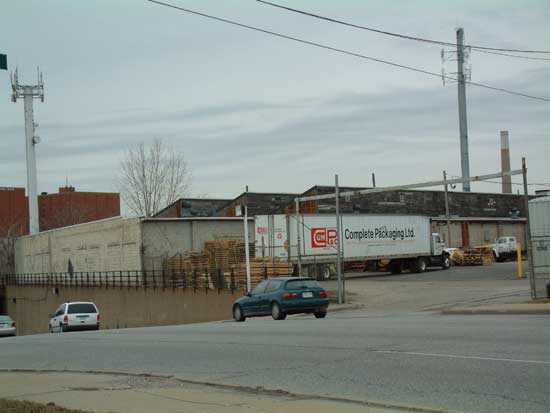 Especially to the rear: The old Service Department: 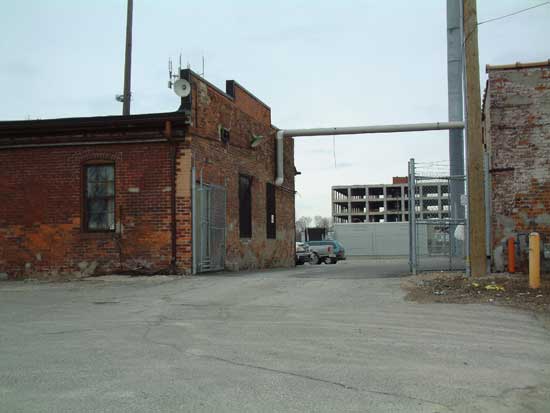 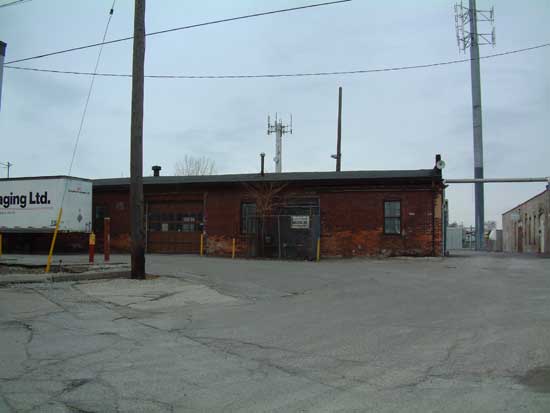 Recieveing room 1. Makes sense as it's next the the railroad tracks. 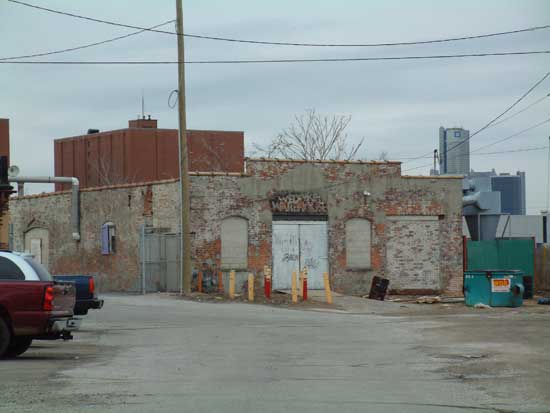 Huppmoble plant: 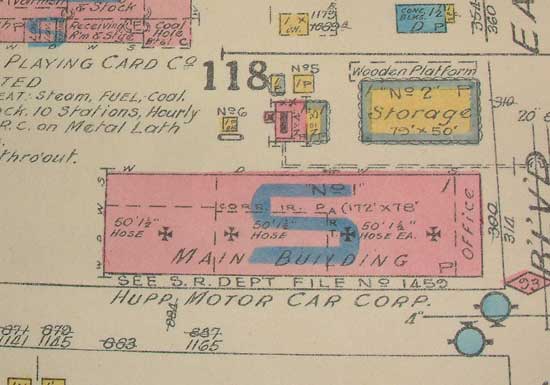 How it looked after opening c. 1913 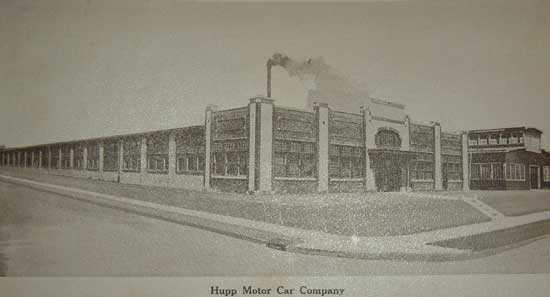 Today: 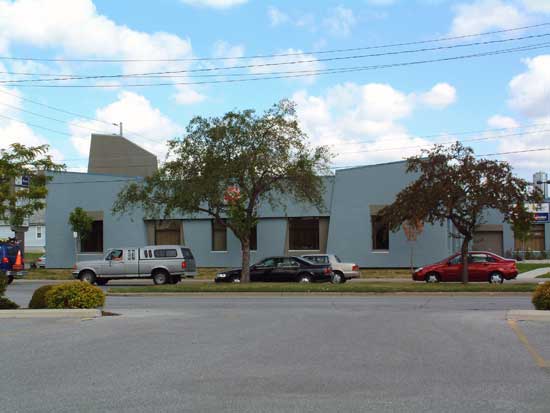 I didn't get a chance to cruise by Kelsy Wheel, but I will try tomorrow. 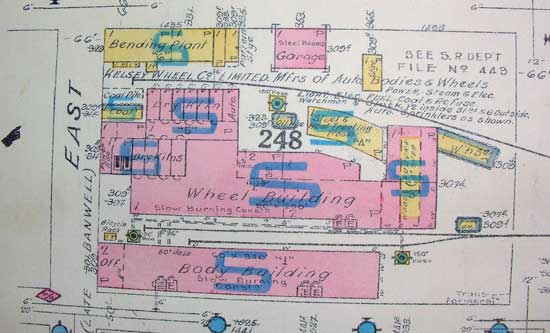 | ||||||||||||||||||||||||
Sven1977 Member Username: Sven1977 Post Number: 29 Registered: 04-2004 Posted From: 209.220.229.254 |
Yes there are fire insurance maps. They are the Sandborn Maps at the Detroit Library. I have not seen them yet but I will be down there on Saturday to have a look. I guess they are on microfilm. They could answer lots of our questions about what was where and when. One of the first things I will do is check what the Cadillac factory on Riopelle used to be. | ||||||||||||||||||||||||
Mikem Member Username: Mikem Post Number: 1303 Registered: 10-2003 Posted From: 68.43.13.241 |
Andrew, great find! How large are those maps? Are they in big booklets, say 24"x36" , sorry, 60cm x 90cm? ; ) What do the different colors mean? Does the "S" mean it's equipped with sprinklers? Sanborn maps at the Burton is another thing on my to-do list. Sven, let us know what you find out about Cadillac. I'd go on Saturday too, but I'm working over the weekend. I have this postcard showing Studebaker's Detroit plants. Interesting that the Piquette Avenue factory is Plant No. 1, considering their home is South Bend. Plant No. 3 is at Clark Avenue at West Jefferson Street. Plant No. 2 must be South Bend? Or Windsor? 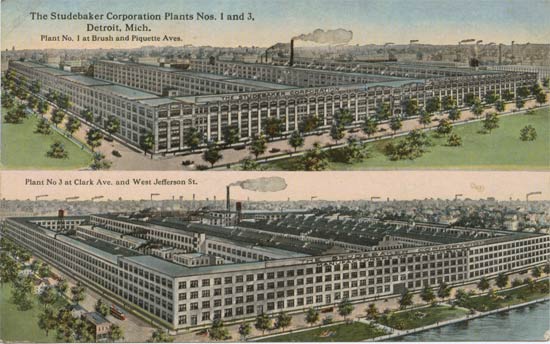 I want to know more about Plant 3, when it was in use, and what did they do there? I'm a little suspicious of these old postcards; I think they took a little liberty with scale. This one gives the impression that it was right on the waterfront but I have the feeling it was really at the southeast corner of Clark and Fort. 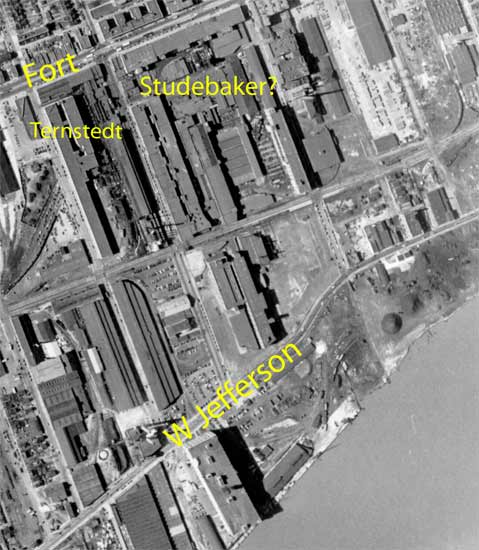 The backside says:
It was mailed on September 4th, 1915 at 7:30 PM (remember twice a day mail delivery?) from Detroit, Michigan to a Mrs. W. M. Moore in Manton, Michigan, Rural Free Delivery route no. 3. "Dear Grandmother, Well, I am in Detroit and having a good time. It is raining today. I'll be home in a day or two. I suppose everything is all right up there? Your grandson, Chester" I hope the big city took good care of the country boy. This decade had to be the center of the down-state migration period from washed-up northern lumbering towns to the big city for those seeking work. Seems I've read that 1913 was the year that population of the counties north of the Muskegon-Tittawabassee Rivers peaked. BTW, guess how much a one-cent stamp cost in 1915? | ||||||||||||||||||||||||
Jjaba Member Username: Jjaba Post Number: 1504 Registered: 11-2003 Posted From: 24.22.6.155 |
The one-cent stamp was put on the penny postcard. That make 2 cents, USD. ($5.00 Canadian) (jjaba always did well in math at Noble School.) jjaba, Westsider thanking you for great info. | ||||||||||||||||||||||||
Jjaba Member Username: Jjaba Post Number: 1505 Registered: 11-2003 Posted From: 24.22.6.155 |
The Studebaker Plant, Clark and W. Jefferson, was built 1910. It was an EMF Plant, (Everitt-Metzger-Flanders,) originally but soon taken over by Studebaker Brothers from South Bend, Indiana. The main four-story bldg. was 1,800 ft. long along Jefferson Ave. with four wings behind it. There were 3 addl. bldgs. running North up towards W. Fort St. Detroit's first automobile strike in 1913 was here. It was organized by the IWW, Intl. Workers of the World, the Wobblies. About 10% of the original complex was still standing a few yrs. ago. jjaba, on the Westside. | ||||||||||||||||||||||||
Mikem Member Username: Mikem Post Number: 1305 Registered: 10-2003 Posted From: 68.43.13.241 |
O.K., that helps. The remaining structure must be the one above the "o" in "Jefferson" but below what I've labeled as "Studebaker?" in the aerial photo? That photo is from '49 so it must have been demolished relatively early. | ||||||||||||||||||||||||
Aiw Member Username: Aiw Post Number: 3502 Registered: 10-2003 Posted From: 209.216.150.127 |
Mike the 24 x 36 seems about right... If not even bigger. They are in several volumes and about 6 inches thick, and weigh a ton. There are copies in the Windsor Archives and Museum. However, the copy I photograped resides at city department. It's easier to use my connections to get in there and go through that copy of the map. As for the "S" it does mean sprinklers are present. Each color repersents something else.... I was smart enough to photograph the legend. I'll post it when I get home tonight. I spent quite a while with the maps, I shot close to 200 photos of it. I still have other stuff to go through. As a map fan Mike, I knew you would like it... As for the plant numbers, I have no idea what plant 2 was. It could have been the Walkerville (Windsor) plant. The Chrysler plant here in Windsor is Plant #3, I always wondered about that. The fire maps solved that mystery for me yesterday. The first plant, long gone was plant 1, then plant 2 was on the South end of the current property, and plant 3 remains as it is. Plant 1 & 2 were demolished leaving only #3. | ||||||||||||||||||||||||
Jjaba Member Username: Jjaba Post Number: 1508 Registered: 11-2003 Posted From: 192.220.139.27 |
The book I have about Studebakers is saying Piquette was #3 and W. Jefferson was #1. Maybe they counted differently back then. It is sort of trying to figure out. I worked for Wrigley's Stores yrs. ago in store 107, at the time Wrigley's had maybe 20 stores. Go look for yourself, W. Davison and Greenlawn. Now a jjaba neighborhood ruins. MikeM should give us a mapping of his approaches into DTW over historic and active auto plant. Something like, "turn left at the dangling plant light on the Hupp Bldg., 3 minutes later, slight right heading over Ford Piquette, then straight over Clark St. Cadillac, lower to 5,000 ft. at Ford Rouge Power plant, out to Ypsi Ford Tranny plant, and circle into runway 24L. Take the inner loop Quebec to your gate. Give us some airplane talk like we get on Ch. 9 on the plane. jjaba | ||||||||||||||||||||||||
Markmahy Member Username: Markmahy Post Number: 1 Registered: 03-2005 Posted From: 12.207.17.137 |
Newbie here. Found this board off the Ruins of Detroit link. If anyone here is really interested in the history of the auto industry, I recommend checking out the book "The American Auto Factory" by Byron Olsen & Joseph Cabadas. It's available from Classic Motorbooks. www.motorbooks.com Mark | ||||||||||||||||||||||||
Rustic Member Username: Rustic Post Number: 1359 Registered: 10-2003 Posted From: 68.164.202.107 |
Markmahy, welcome! | ||||||||||||||||||||||||
Mikem Member Username: Mikem Post Number: 1306 Registered: 10-2003 Posted From: 68.43.13.241 |
Hi Mark and Welcome also! That is a great book as is the new one on the Rouge from the same source: http://www.motorbooks.com/Stor e/ProductDetails_16139.ncm I also recommend: "How Detroit Became the Automotive Capital" by Robert Szudarek "The Rational Factory" by Lindy Biggs "The Changing US Auto Industry" and "Making and Selling Cars" both by James Rubenstein jjaba, I know where you're getting that info on Studebaker. Did you notice the description of Studebaker's Piquette plant says the W Jefferson plant produced autos only through 1928? Going back to the Fleetwood plant on Fort @ West End, the same source has this to say: "The first sections of this plant were built in 1916-1917 under a government contract to produce the Italian Caproni Bomber, the J-1 Trainer, and the British DeHaviland fighter. It remained an aircraft plant until December 1918 and then the Fisher Body Company bought the property from the United States Government. The oldest buildings in this complex include buildings Number 1 (1917), 2 and 3(1918), and 4 (1919), all single-story steel-framed structures designed by the Detroit architectural firm of Smith, Hinchman, and Grylls. All four front on West End Avenue and have aluminum siding exteriors added in 1974. Building Number 6 (1922) is a six-story reinforced concrete structure, 100 feet wide and 979 feet long, designed by Albert Kahn. The plant was used to produce Ford, Dodge, and Chrysler-Maxwell bodies prior to 1926, when Fisher Body became a subsidiary of General Motors. They made LaSalle bodies here in 1926-1940 and produced tank and aircraft parts during World War II. Since then, the plant has mainly been used to produce Cadillac bodies and typically turns out about 200,000 per year." Sorry jjaba, no airplane talk today. I saw Airport'75 earlier this morning and that's enough bad acting for one day! | ||||||||||||||||||||||||
31ford Member Username: 31ford Post Number: 191 Registered: 10-2003 Posted From: 205.188.117.68 |
Has anyone read the book "Albert Khan: Architect of Ford" ? I was plundering around on Amazon and found it and ordered a copy, I hope it's a good read..... Ford's book "My Life and Work" is an excellent book for getting the feel of how the early days of assembly lines work, he goes into detail about how the scrap from this goes into making that, good read, tho ghostwritten By Samuel Crowther. Aiw and MikeM, excellent resources y'all have been posting, gives a neat perspective esp. to this groundpounder. | ||||||||||||||||||||||||
Jjaba Member Username: Jjaba Post Number: 1515 Registered: 11-2003 Posted From: 24.22.6.155 |
Fleetwood Plant, last paragraph. The Fisher Body Fleetwood plant at W. Fort Street and West End Avenue (1917-22), was named after Fisher's bought the Fleetwood Custom Body Company, of Fleetwood, Penna. That production was moved to Detroit into this plant in 1933. Fleetwood, Penna. in 1933 is a village of 3,450 people, is 50 miles West of Allentown (where they are tearing all the factories down.) Fleetwood today is a village of 3,450 people. jjaba, with some editorial comments to the book, Charles K. Hyde, "Detroit: An Industrial Histroy Guide." The Fleetwood was THE name for Cadillac's giant of a luxury car back in the day. | ||||||||||||||||||||||||
Mikem Member Username: Mikem Post Number: 1307 Registered: 10-2003 Posted From: 68.43.13.241 |
jjaba, explain to me if this is a "factory" or a high school. Did any autos roll off the line here?: 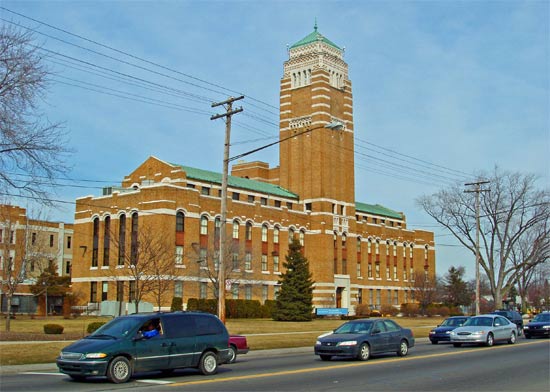 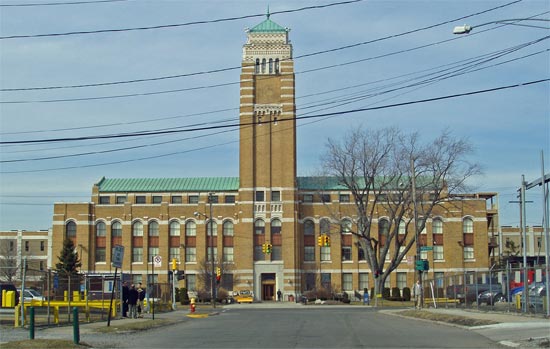 | ||||||||||||||||||||||||
Toolbox Member Username: Toolbox Post Number: 405 Registered: 10-2003 Posted From: 69.14.30.83 |
That is the old Nash Kelvinator Building now known as PROC (Plymouth Road Office Complex) or JTE (Jeep Truck Engineering) depending on who you ask. Don't leave you ar unattended there, they lose several a week from those lots.
(Message edited by toolbox on March 24, 2005) | ||||||||||||||||||||||||
Rustic Member Username: Rustic Post Number: 1361 Registered: 10-2003 Posted From: 130.132.177.245 |
Mikem, lol I always thought it looked like a church! Of course that was the HQ and engineering office for Kelvinator which eventually became the HQ and Engineering offices for AMC (AMC also built a tower out in Southfield in the late 70's so I'd suspect this was mostly engineering and design here by the time Chrysler bought them). IF there was ever any mfg at this site it would have been WAAAAY back in the olden days, check your old pre ww2 detroit streetmap but I doubt that there was any mfg going on here, this was greenfield development back when this was built. Since AMC cut waaaaay back on their white collar operations in Kenosha by the late 60's early 70's I THINK it was the design site for: (1) the smart 70's Hornet compact, (2) the unfortunte but daring Pacer, (3) the ahead of it's time Gremlin (laugh at it all you want, it was nicer than the 1970's Pinto, Vega and that stinko Japanese import rebadged as a Dodge and by the 80's with all of the Omni's, Chevettes, Escorts, Tercels etc on the roads lots of people were driving Gremlin equivalents), and (4) the similarly ahead of it's time Eagle (gee how stupid to think there is a market for an all wheel drive sedan? lol). (I suspect the Grand Wagoneer was still designed in Kensoha tho.) | ||||||||||||||||||||||||
Sven1977 Member Username: Sven1977 Post Number: 31 Registered: 04-2004 Posted From: 209.220.229.254 |
Get out your maps, yes get them out. I've been wanting to go to the library for the last year to check out the insurance maps. But somehow, going to the library never seems to be a priority on a Saturday. Thanks to AIW, I was motivated last night. My first time ever at the Detroit Public Library. Caution: Don't park where I did. It was $7.00 for less than two hours. The old maps are on microfilm. The index is awful. There are volumes which disect the city into sections. But the index doesn't exactly reflect the years on the reel. The reel I looked at included 1928. Actually a very good year for this kind of thing. The region I picked is the Milwaukee Junction area. I photocopied anything that I could see that looked interesting. At some point, I will transfer the info to a map but for now, you'll have to use your own map. Most of the time, if someone wants to know what a building is, they just ask MikeM. But he wasn't around so here goes: Studebaker factory west of Brush on Piquette is Plant #1. Studebaker factory east of Brush on Piquette is Plant #10. Fisher Body Co. and Fisher Closed Body Co. at St. Antoine. Between Piquette and "Trombley" train tracks is Fisher Plant #3. This area also includes Glayton & Lambert Mfg. Co. East of St. Antoine is Fisher Plant #2 and Plant #4. East of Oakland is Fisher Plant #5. Between the tracks and on Hastings with St. Antoine to the west is Jenks & Muir Mfg. Co. Mf'r of Iron & Brass Beasteads (?) Wire & Fitted Mattre's, Feather & Cotton Comforts. Between Hastings & Masur on Harper is Fisher Plant #9. South of Harper and east of Hastings is Fisher Plant #8. Between Piquette & Harper and St. Antoine & Hastings is (what the map says) is Fisher Paint & Trim Shop (what everyone calls Plant 21) built in 1919 and Plant #7. (I think it's a parking lot now) South west of East Grand Blvd. & Riopelle is Fisher Plant #21. It is pretty small and also on the block is a vacuum cleaner company and Oldberg Mfg. Co., Mfg. of mufflers. North of Milwaukee, east of Riopelle, south of East Grand Blbd. and west of the Dequindre tracks is McCord Mfg. Co. M'f'rs of Automobile Specialties and Railroad Supplies. Schwanbeck Bros. Box and Showcase factory is also in this block by the tracks. North of Milwaukee, east of the tracks is Fisher Body Plant #12. South of Trombley, west of the tracks is the American Radiator Co. North of Harper, west of the tracks is the Murphy Chair Company. South of Trombley, west of Widman Pl., east of the tracks is Cadillac Plant #2. South of Ferry, west of the tracks, east of Riopelle is the American Car & Foundry. North of Warren, west of the track is the John J. Bagley & Co. Tobacco Factory. (this should be one of the buildings in my pictures of the unknown Cadillac plant) South of Warren, east of the tracks is the Fisher Body Lumber yard. At 722-734 East Forest (south of the road) is Fisher Plant #11. It's pretty small. Between Riopelle and the tracks and between Farsworth & Theodore is Fisher Body Plant #10. Built in 1917 and 1919. This must be the Cadillac plant in my pictures. I'm sorry this is so confusing. The photocopies aren't the best and to put up every copy sized correctly would probably take forever and be unreadable anyway. I tried to size a few to 56k and then the system it wanted it at 50k. If you have any questions, let me know. Somehow, I missed the Ford Piquette plant and most of the Russell Complex. Next time I guess. | ||||||||||||||||||||||||
Aiw Member Username: Aiw Post Number: 3511 Registered: 10-2003 Posted From: 209.216.150.127 |
Thanks for the info Sven. How much are photocopies at the Burton from Microfilm? | ||||||||||||||||||||||||
Kathleen Member Username: Kathleen Post Number: 392 Registered: 10-2003 Posted From: 140.244.107.151 |
Throughout DPL, copies from Microfilm are 25 cents per page. Photocopies are 10 per page. Sven didn't say if he ended up using the microfilm in Burton or General Information. Don't forget that Burton HC charges $10 a day for non-City residents when the librarians provide services. Not sure if those services include retrieving microfilm from the Burton HC itself. | ||||||||||||||||||||||||
Sven1977 Member Username: Sven1977 Post Number: 32 Registered: 04-2004 Posted From: 209.220.229.254 |
I used the Sanborn Maps in the maproom. The use was free. The copies however... I went to the bank today to get a roll of quarters. They will make change though. | ||||||||||||||||||||||||
Aiw Member Username: Aiw Post Number: 3515 Registered: 10-2003 Posted From: 209.216.150.127 |
Sweet! That's a great deal. Over here in Windsor copies from Microfilm in the refernce section of the library are $1.00 each! I go broke every time I'm in there. | ||||||||||||||||||||||||
Sven1977 Member Username: Sven1977 Post Number: 33 Registered: 04-2004 Posted From: 209.220.229.254 |
Anyone, What procedure do I use to copy a Tera Server picture, write on it and spit it back out as an attachment to upload. Kathleen, do you work with the Automobile Heritage group? | ||||||||||||||||||||||||
Mikem Member Username: Mikem Post Number: 1308 Registered: 10-2003 Posted From: 68.43.13.241 |
Nice finds Sven! I was trying a couple different ways to do just that. First, I have basic GIS software but when I save the maps I make, I can only save them as bitmaps, and when downsizing and converting to jpeg they get real fuzzy: 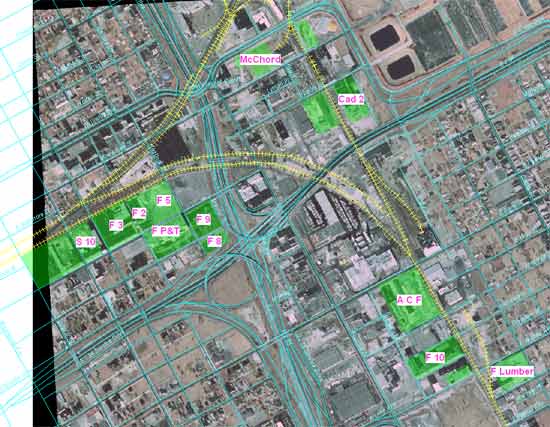 Then I tried labeling terraserver images too, but the same thing tends to happen, especially to the text. Maybe if I used older black&whites it would turn out bettr. I save the terraserver images then use Photoshop to add to it. F= Fisher, S=Studebaker 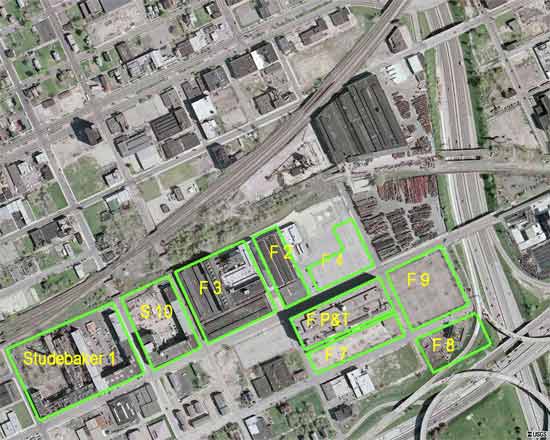 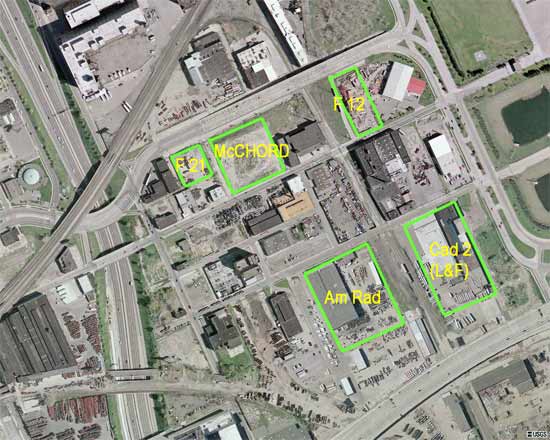 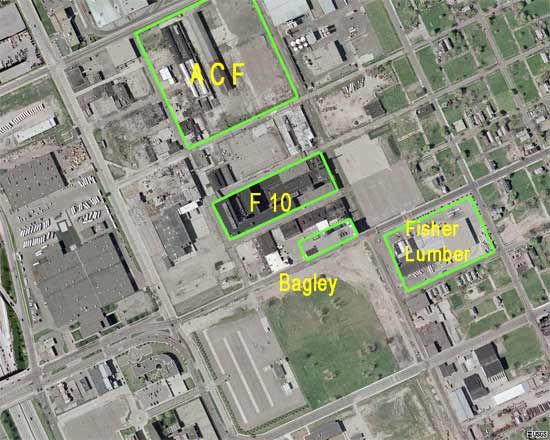 (Message edited by MikeM on March 24, 2005) | ||||||||||||||||||||||||
Mikem Member Username: Mikem Post Number: 1309 Registered: 10-2003 Posted From: 68.43.13.241 |
Also, my GIS software won't show every label; it drops some so they don't interfere with each other. Without the aerials in .gif format: 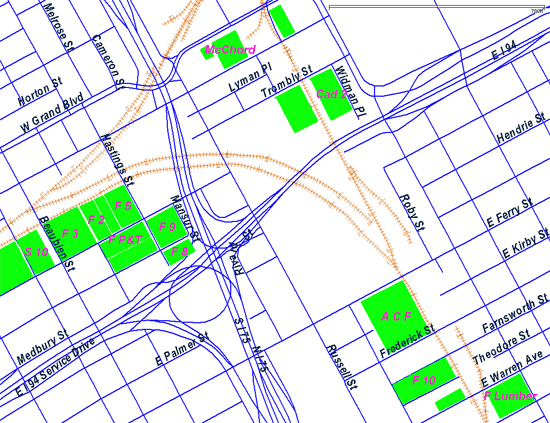 | ||||||||||||||||||||||||
Sven1977 Member Username: Sven1977 Post Number: 34 Registered: 04-2004 Posted From: 209.220.229.254 |
Great! Thanks for your work. Now we can really start putting lesser known buildings at their locations and match up with the pictures. | ||||||||||||||||||||||||
Mikem Member Username: Mikem Post Number: 1310 Registered: 10-2003 Posted From: 68.43.13.241 |
I'm not sure if I got the locations exactly right. There was some ambiguity as to which side of the street you were referring to. From this description: " South of Trombley, west of Widman Pl., east of the tracks is Cadillac Plant #2.", I have this building: 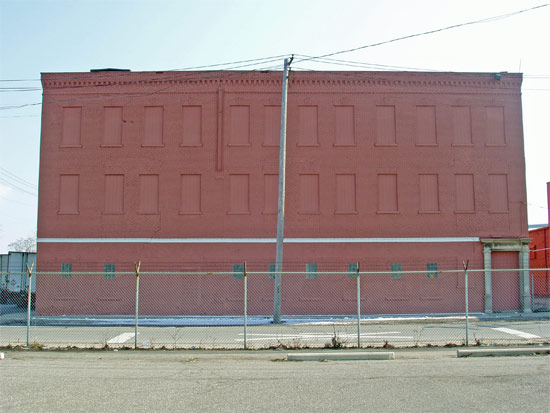 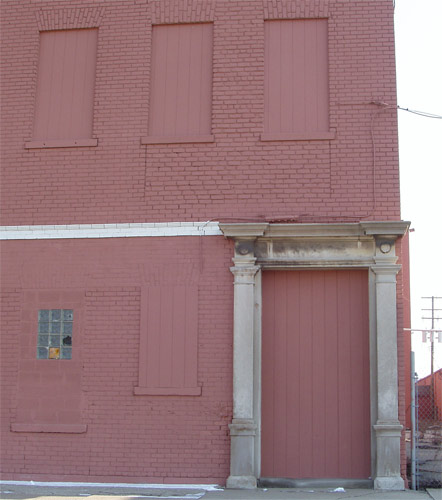 Earlier when I was trying to figure out if the Leland & Faukoner (Cadillac2) shops were still standing, I was posting pictures of the building north of Trombley (ArcoAlloys), not south. | ||||||||||||||||||||||||
Jjaba Member Username: Jjaba Post Number: 1517 Registered: 11-2003 Posted From: 24.22.6.155 |
Sven, see if you can find jjaba's father's shop, Smith Envelopes, 2360 E. Grand Blvd, NE corner of DuBois. He worked there starting in 1928. St. Aubin and the RR overpass was very close. Today, the Blvd was widened, rounds the bend there with the land in the street. This happened when GM went in. jjaba | ||||||||||||||||||||||||
Mikem Member Username: Mikem Post Number: 1311 Registered: 10-2003 Posted From: 68.43.13.241 |
"Between Riopelle and the tracks and between Farsworth & Theodore is Fisher Body Plant #10. Built in 1917 and 1919. This must be the Cadillac plant in my pictures." 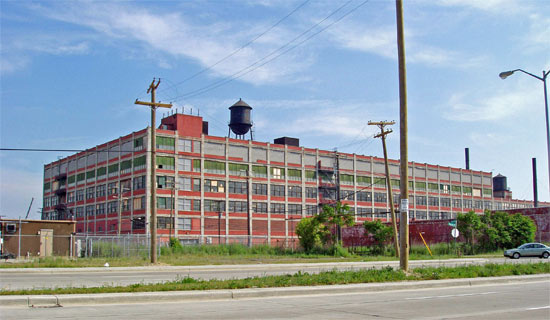 You can barely make out the: "CADILLAC MOTOR CAR DIVISION" "GENERAL MOTORS CORPORATION" I can't make out the bottom line, must be the address. 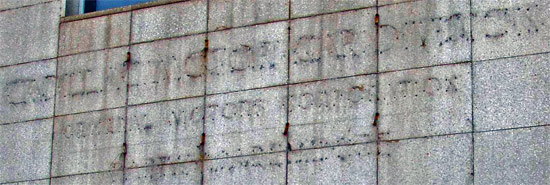 BTW, did you catch the old wooden Theodore street sign? 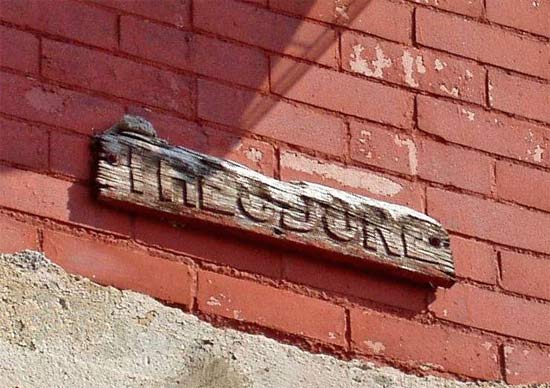 | ||||||||||||||||||||||||
Jjaba Member Username: Jjaba Post Number: 1518 Registered: 11-2003 Posted From: 24.22.6.155 |
MikeM knows when he's in jjabaland with Nash-Kelvinator. We're talking deep Westside here. So you need a Rustic and a Toolbox, plus jjaba to bat clean-up to describe it. The Miller-Storm Development Company built the Mark Twain housing neighborhood 1927-31. Houses cost $5,000-15,000 range for substantial Tudor Revival Bungalows. The workers walked to the nearby Electric Refrigeration plant of 1927 on Plymouth Road at Mark Twain St. In 1937, Nash Motors which began in 1916, moved in as Nash-Kelvinator. The Nash nameplate stood independent until 1957 when they were swallowed by American Motors in Kenosha. After that, George Mason moved them into a Rambler small car mode, selling these smaller cars. Some might remember the Metropolitans of 1954-59 which turned around in my backyard in front of the garage. The towered Admin. Bldg. of 1927 enhanced the neighborhood. It was both of beauty and utility. The lines are honest, wholesome, and structural. The Nash-Kelvinator Admin. Bldg was designed by Amedeo Leoni, the industrial layout by Wallace Mc Kenzie, and tower enclosure and industrial units by William E. Kapp, of SHG. Ok, so GM and the Fisher's had their little ensemble on The Boulevard, Ford had his big deals in Deraborn, but this little jewel was the pride of our neighborhood. You saw the photos today. Props to Chrysler for keeping it open. As for the parking lot, use a siren and The Club to deter thieves. Blame the Canadians and our open borders. jjaba, Proudly Westside. | ||||||||||||||||||||||||
Sven1977 Member Username: Sven1977 Post Number: 35 Registered: 04-2004 Posted From: 209.220.229.254 |
Mike you are so right on with your mapping. I have a couple of corrections. (Not that it really matters) 1. My date is wrong. The info is from 1921. Maybe the box was wrong and that's where I got 1928, but I wrote 1921 all over my sheets. 2. Move Fisher 21 to the left a bit. It could be the the building that shows up in the Russian spy photo. I believe there is a fire station at Riopelle & Milwaukee that is still standing and that shows in the map. Addition: At the SW corner of Piquette & St. Antoine on the map is an office for the Regal Motor Car Company. Regal went out of business a few years earlier. They had a big complex at one time. The address is 201 Piquette. I think it's a vacant lot now. Mike, I double checked my descriptions for Cadillac on Trobley and it makes sense. Too bad the address isn't there. There are five buildings right on the street. It's probably 298 which has an office in front. It's in the middle of the block. I will look for Smith's Envelopes on my next adventure. I think I can sqeeze in a few hours early afternoon on Saturday. The section of Detroit I was looking at was south of EGB. Why I didn't see anything of interest north of Trombley until Milwaukee is strange. There's a gap there for some reason. | ||||||||||||||||||||||||
Jjaba Member Username: Jjaba Post Number: 1520 Registered: 11-2003 Posted From: 24.22.6.155 |
jjaba can assure you that 2460 E. Grand Blvd., Detroit 11, Michigan is a widened E. Grand Blvd. today. But he would love to see it listed on the maps and any descriptions you can add. On the NW corner, of the Blvd. and Dubois was a little Mobil gas station. Mc Chord's probably was very close-by. Also, the RR overpass and St. Aubin St. were closeby. jjaba, trying to remember such details. | ||||||||||||||||||||||||
Mikem Member Username: Mikem Post Number: 1313 Registered: 10-2003 Posted From: 68.43.13.241 |
The fire station is the building next to the "d" in McChord, on the north side of Milwaukee. Here's a postcard of Regal although I don't know if its at 201 Piquette. I thought I read that they had a plant on Woodward, and I've seen old magazine ads that show the company's address as 7250 Piquette. They were in business 1907-1920: 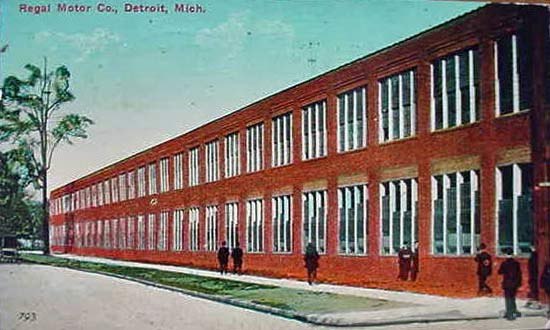 The lettering on Fisher 10 is above the door facing Riopelle and has a current address of 5140 Riopelle. A search of the city's property page shows date of construction as 1919. The building occupying the block to the north has an address of 5231 Dequinder, built 1929, and is informally known as G.M. Parts Division #10! Who knows what the addresses were back then, especially when they take up a whole block, with many entrances. Thanks Toolbox, Rustic, jjaba for westside history. Did Nash buy or merge with Kelvinator? I see they during the war they made R-6 helicopters, field refrigerators, aircraft propellers and propeller governors, bomb fuses, and chemical bombs. You guys do funny things over there - this is the first factory that I've seen a truckload of new cars goinginto instead of coming out of. | ||||||||||||||||||||||||
Toolbox Member Username: Toolbox Post Number: 409 Registered: 10-2003 Posted From: 69.14.30.83 |
They will steal cars from the gaurded lot and run the gate. Once the gate was redone it looks like some kind of military check point with no straight line through so you need to slow to a crawl to exit. One week in the lates 90's they lost 10 prototype Cummins HD pickups. There were changes fast after that. Mike this is an R&D facility(truck version of CTC) and not a factory per say. There was a small pilot plant on site but most of the assembly is done by hand in the many labs on site. It is a very impressive space inside but it is a bitch driving a long bed extracab inside it. | ||||||||||||||||||||||||
Aiw Member Username: Aiw Post Number: 3521 Registered: 10-2003 Posted From: 64.228.193.180 |
To comment on Rustic's post above. My grandfather was an AMC lover. He had both a Gremlin and a Hornet. They were great cars, I almost bought a Hornet a few years ago, just for fun... | ||||||||||||||||||||||||
Mikem Member Username: Mikem Post Number: 1315 Registered: 10-2003 Posted From: 68.43.13.241 |
Anyone recognize this place on Tireman, east of Wyoming and just up the tracks from DeSoto/McGraw and Graham-Paige? Looks like that Chrysler blue too. Wondering if it was another in the westside chain of Chrysler's? 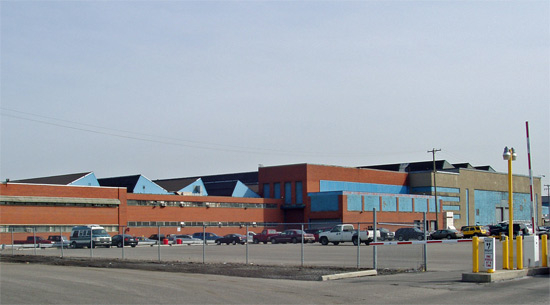 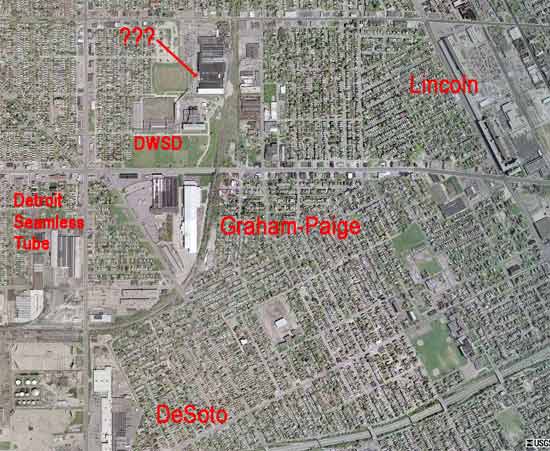 That's it for me for a while; I'll be on the road through the weekend. Unlike Bate,I can't escape the technology. | ||||||||||||||||||||||||
Aiw Member Username: Aiw Post Number: 3522 Registered: 10-2003 Posted From: 64.228.193.180 |
Mike, that really looks like the unmistakable Chrysler Blue. | ||||||||||||||||||||||||
Rustic Member Username: Rustic Post Number: 1368 Registered: 10-2003 Posted From: 68.164.202.107 |
jjaba, mikem is curious about westside stuff, ya think he his ready for a tour of the old chop shops up and down livernois that supplied illicit car parts to the greater Detroit area for generations (run btw by familes with links that went back to the purple gang itself). lol but that's another thread! Mikem, I believe Chrysler had a parts plant thereabouts. I can't say for sure that is what's in your photo, but it makes sense. Aiw, I grew up in a Rambler house. My Dad had nash/Rambler/amc station wagons continuously for something like 30+years -- as long as they kept makin' 'em he'd buy 'em every 7 years or so ... I spent a good part of my childhood weekends working on the last couple of those wagons, lol! I only had one Rambler myself as an adult tho. | ||||||||||||||||||||||||
Aiw Member Username: Aiw Post Number: 3524 Registered: 10-2003 Posted From: 64.228.193.180 |
Like wise Rustic. My family inherited the last Hornet after my Grandfather's passing in the early 80's. Many a weekend was spent with my dad under the hood... | ||||||||||||||||||||||||
Jjaba Member Username: Jjaba Post Number: 1524 Registered: 11-2003 Posted From: 24.22.6.155 |
jjaba grew up in a GM household. Dad had this fantasy of improving from Chevy to Pontiac to Olds, to Buick, to Cadillac in one lifetime. He ran outta time with the 1960 Olds, a block- long powder blue dreamboat. He told everybody he was a "GM Man." Jews weren't too crazy for Henry Ford as you can imagine. Although, many Jews were in Ford's employ from shop to engineering to office. Jews still aren't too hot on German products even today either. In jjaba's youth, Livernois was small car lots with the three-step shoe-box offices, car dealers, and car servicing places like tires, brakes, seat covers, body shops, wash racks etc. but your comments explain why we had an inventory of Nash generators in our old coal bin. MikeM has really done some amazing research for us. Let's hire a B-757 for his delux tour someday. jjaba, Westside Bar Mitzvah Bukkor. | ||||||||||||||||||||||||
31ford Member Username: 31ford Post Number: 195 Registered: 10-2003 Posted From: 205.188.116.195 |
prob old news for most of you, but the book "Albert Khan: Architect of Ford" came in today's mail. VERY well written with lots of photos and Khan buildings other than Ford's. I've just started reading it and am impressed with it. Also "Rouge pictured in it's prime" by Ford Bryan is a worthy purchase, excellent archive photos etc... | ||||||||||||||||||||||||
Mikem Member Username: Mikem Post Number: 1316 Registered: 10-2003 Posted From: 208.54.94.89 |
Hi Ford, I'm just up the road tonight in Orlando. You should check out "The Rational Factory" by Biggs; the book briefly traces the development of the factory and the goal of perfecting its design for its use. The author devotes a couple of chapters to Ford and the Highland Park and Rouge factories. | ||||||||||||||||||||||||
Aiw Member Username: Aiw Post Number: 3534 Registered: 10-2003 Posted From: 64.228.193.180 |
Here's a postcard I just got of Windsor, probably from the 1960's. The Fisher Body Plant is still standing before it burned down. 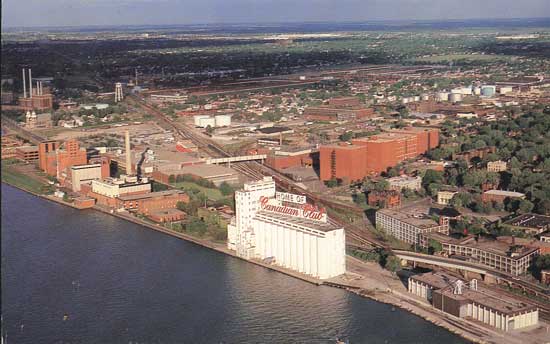 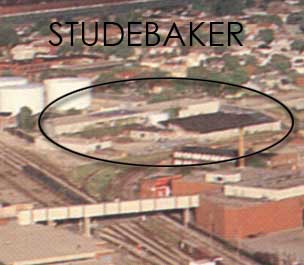 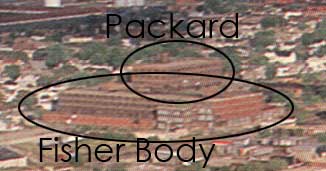 | ||||||||||||||||||||||||
31ford Member Username: 31ford Post Number: 196 Registered: 10-2003 Posted From: 64.12.116.195 |
Thanks for the tip Mike, are you enjoying the humidity and heat? I'm in Lakeland 'bout 30 miles west of ORL.. | ||||||||||||||||||||||||
Aiw Member Username: Aiw Post Number: 3535 Registered: 10-2003 Posted From: 64.228.193.180 |
Here are some scans from "Industrial & Commercial Buildings" By Albert Kahn, 1936. All buildings are in Detroit. American Blower Company, Machine Shop 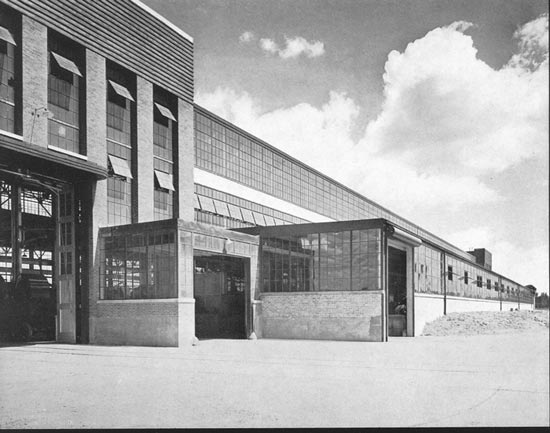 Cadillac Engineering Building 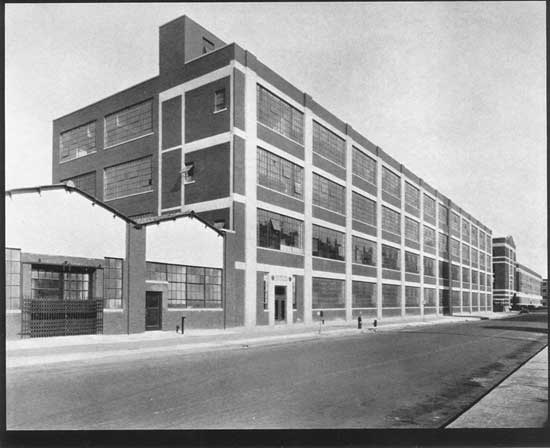 Chevrolet Forge & Heat Treat 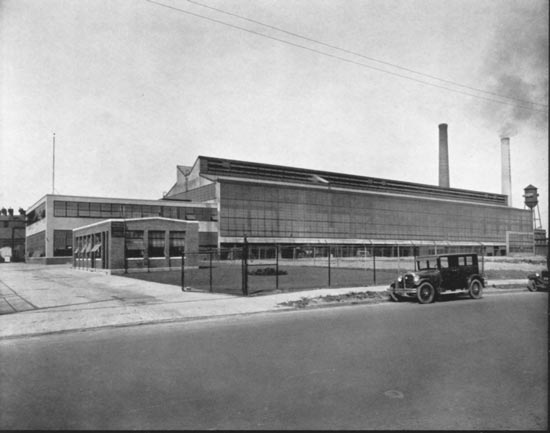 Fisher Body, not sure which # 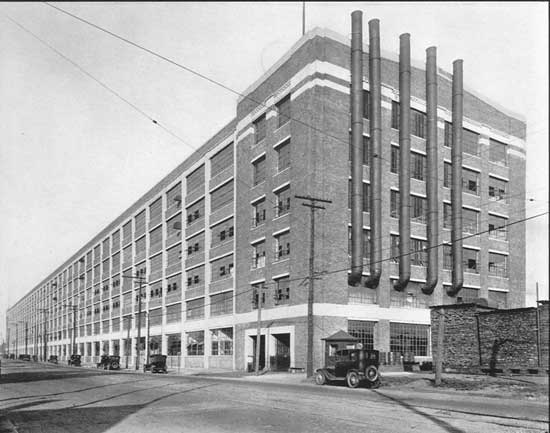 General Offices Paige Detroit Motor Company 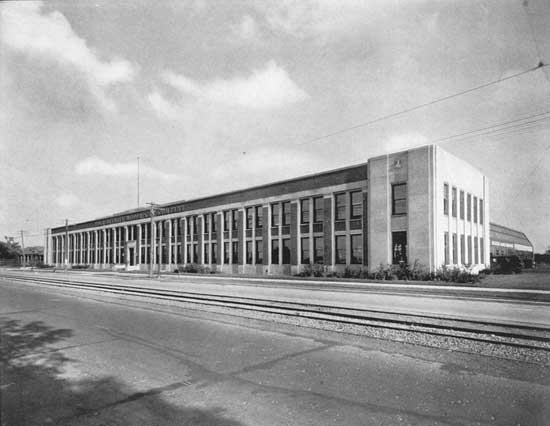 National Products, machine shop 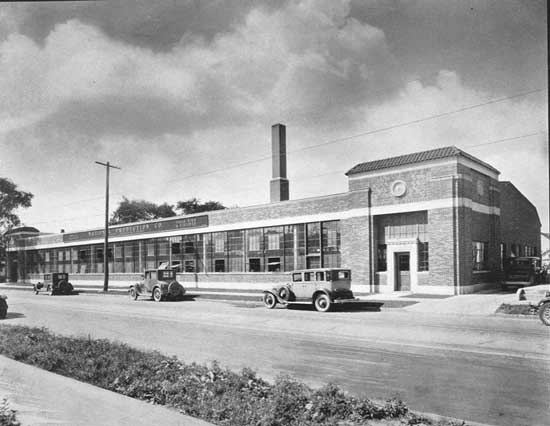 Body Plant, Murray Corporation 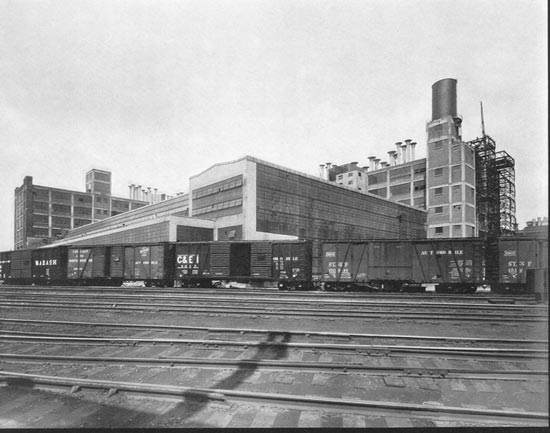 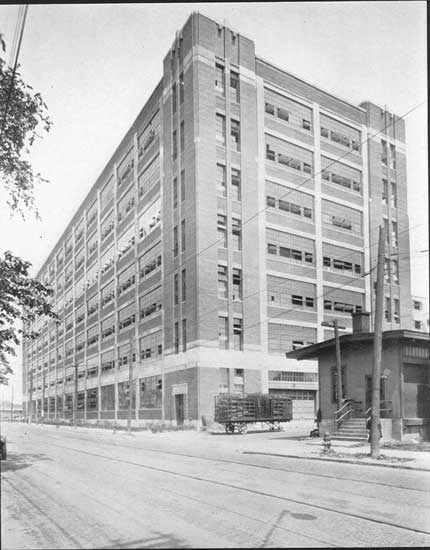 | ||||||||||||||||||||||||
Aiw Member Username: Aiw Post Number: 3536 Registered: 10-2003 Posted From: 64.228.193.180 |
Packard Powerhouse (now demolished) 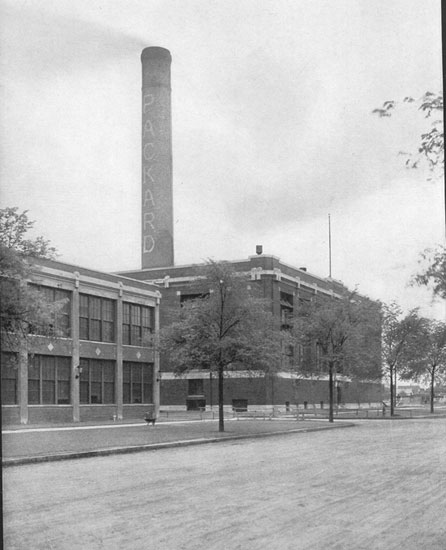 Plymouth Plant 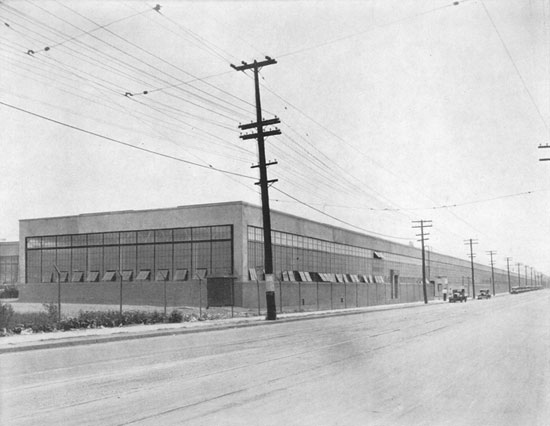 Chrysler Press Shop 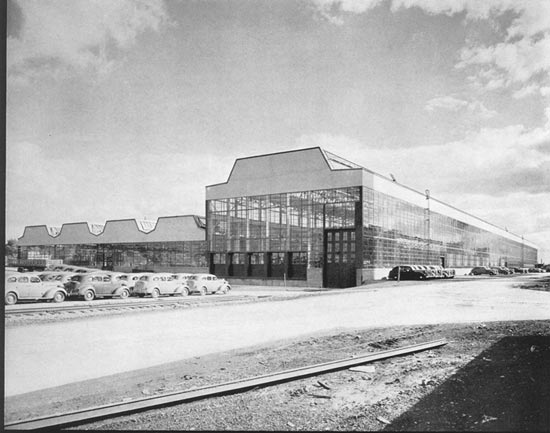 Interior 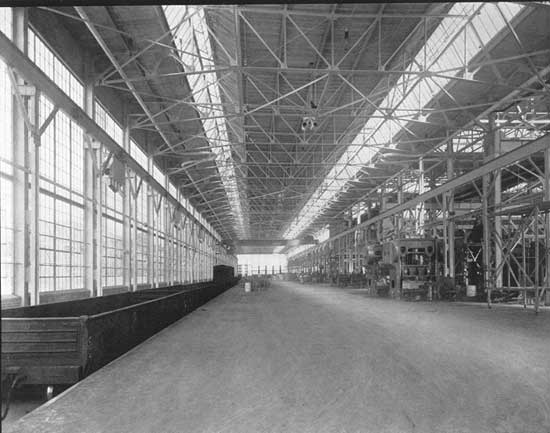 Vickers Precision Machine Shop 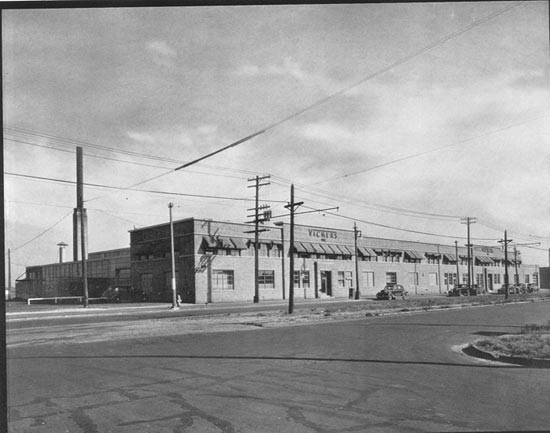 | ||||||||||||||||||||||||
Gianni Member Username: Gianni Post Number: 34 Registered: 05-2004 Posted From: 69.3.205.40 |
Mikem you deserve an award for citing Phillip Levine AND "Detroit I Do Mind Dying" here in one thread. Integrating the literary, political/historical, and geographic. And in a very tangible almost personal way with the photos and maps. Since they aren't using it this year anyway, I nominate you for the Stanley Cup. Sven, I have wanted to check those maps out too, ever since I saw all the footnotes to them in "Arc of Justice," a new book about the Ossian Sweet case. There are many references to the Sanborn maps, which apparently are a gold mine for historians doing research on cities. They show details of every building and even parts of buildings, including individual residences. You can buy the maps but I'd like to check them out in the library. I assume you are talking about the Main Branch in the Cultural Center area? | ||||||||||||||||||||||||
Lowell Board Administrator Username: Lowell Post Number: 1045 Registered: 10-2003 Posted From: 66.167.59.244 |
This is the absolutely greatest thread ever. Thank you all. Kudos to MikeM, AIW and special props to super newbie Sven1977 who hits a grand slam on his seventh time at bat!
| ||||||||||||||||||||||||
Aiw Member Username: Aiw Post Number: 3539 Registered: 10-2003 Posted From: 64.228.193.180 |
Thanks Lowell, This thread really is fun and refreshing... As promised earlier... Here is the fire Insurance Map legend: 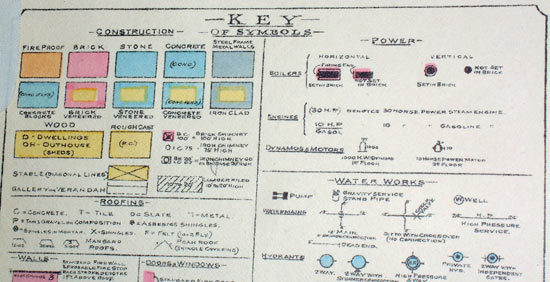 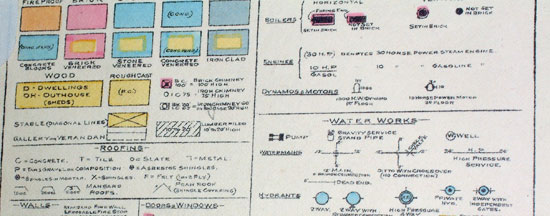 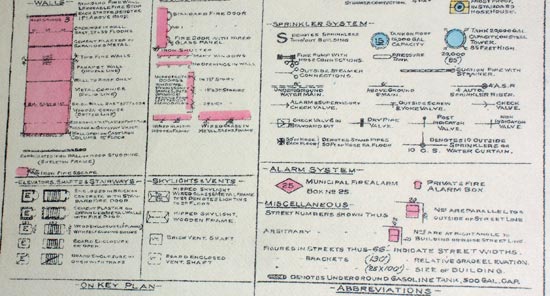 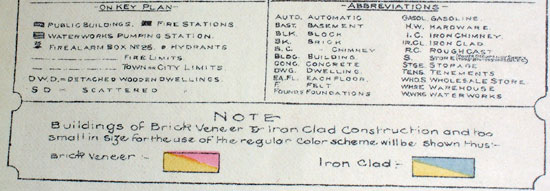 | ||||||||||||||||||||||||
Aiw Member Username: Aiw Post Number: 3540 Registered: 10-2003 Posted From: 64.228.193.180 |
Gianni, You can learn tons from the maps. Here is my house for example: 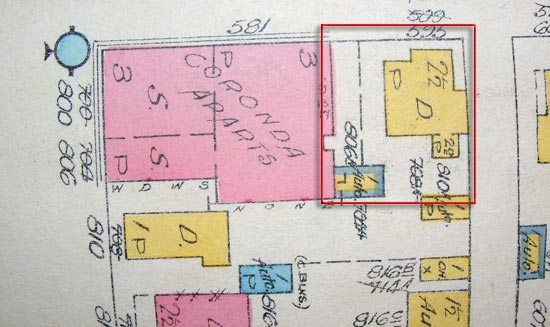 It tells me I have a 2 1/2 story wood dwelling, with a tar & gravel or compostition roof. It also shows that at one time I had a 1 story iron clad garage in my back yard that belonged to a tennant of the store in the apartment building next door. The garage and retail next door are both long gone, as is what ever agreement was in place. It shows as being storage for an Auto, but maybe the retail store used it for stock? The garage made it to the 70's as you can see the shack in some old phots I have come across... The outline of the garage still shows however to this day on the bricks of the apartment building... (Message edited by aiw on March 27, 2005) | ||||||||||||||||||||||||
| Discuss Detroit » Hall of Fame Threads » Old Car Factories » Old Car Factories - 4 |
|